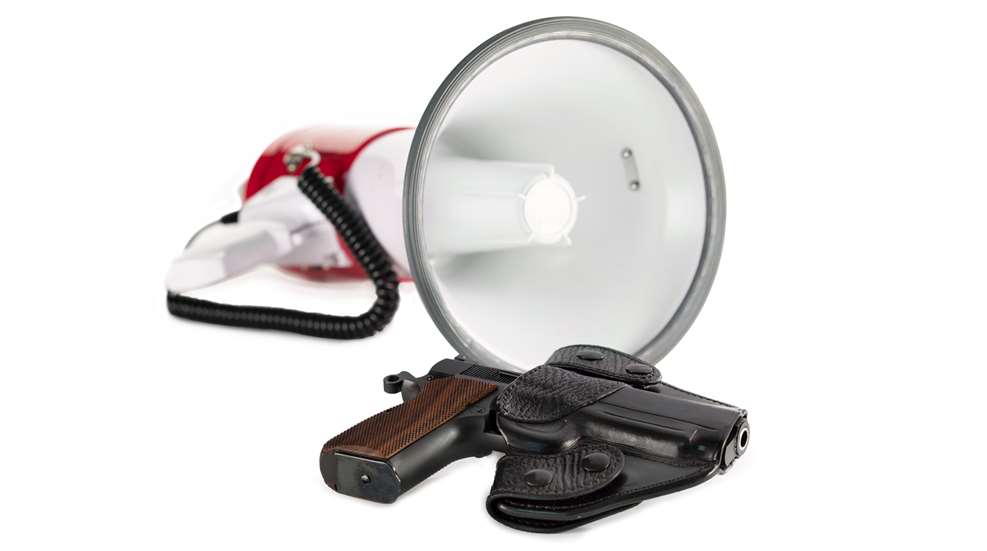
If you think about it, we spend our entire lives using our voice to get what we want and to try to avoid what we don’t. It is interesting how some folks develop this into quite an art, while others don’t have a clue. That is also true when we consider self-defense, although we rarely discuss using voice as a tool.
I remember one deputy in the sheriff’s department in North Texas. He was a portly sort of fellow whose shirttail always seemed to be out, but we soon learned that there was more there than met the eye. Mr. Jones’ specialty was dealing with the emotionally disturbed, a situation that can be quite dangerous and one every officer dreads. Jones, however, just had a way of talking to those folks that quieted them right down. I never saw him use physical force, and I am quite sure he never even drew his gun. He just had a way of talking.
Another example came to me regarding a friend that I’ll call Bob. One evening Bob was enjoying a meal at a restaurant/bar with some friends. He had noticed a fellow in there who seemed to be a little drunk and looking for a fight. Soon, he fixed his eyes on Bob and rapidly moved closer.
Before the guy could start a fuss, Bob jumped up with a grin on his face and stuck out his hand. “Aren’t you Andy Johnson? It’s been a long time and I’m sure glad to see you!”
Before he could even answer, Bob said, “Didn’t you go to Jefferson High School? Well, sit down, anyway, and let’s visit.” The guy was so befuddled that he did sit down and quiet down. Pretty soon, he and Bob were visiting like long-lost friends. Bob had never seen the guy before, but he had found a way to defuse the situation and avoid a fight.
We can use our voice to defuse a situation, and we can use it to overpower another. The key lies in knowing which way to go in a given situation.
When we are dealing with an upset neighbor or the other guy in a traffic accident, we may not resolve anything by getting angry. In fact, that usually is not the way to resolve these problems. We may well be better off using a calming, diplomatic approach. We can do this without surrendering our position if we’ll just give it some thought. And, if they still choose to resort to violence, at least we tried. Remember, you can prepare to defend yourself while you still have a smile on your face and a calm voice.
Even when faced with a potentially deadly situation, we need to consider the words that we are using. I laugh when I hear someone say, “Put your hands up!” You have just told the attacker to move and now you have to decide if he is moving to comply or moving to go for a weapon to continue the attack. It is far better to command him to not move.
Also, it is important to use a command voice, even if you doubt that you are really in command of the situation. The command voice is loud and authoritative. It should also deliver a brief, clear command.
In our defensive classes, this is one of the things we find many students have trouble with—using the command voice. Too often, they are scared and sound scared. Well, anyone in their right mind is a little bit scared when faced with a threat, but you shouldn’t act like it. Instead, you want to act and sound in such a way that the crook thinks this might be the worst mistake he’s ever made.
It is also important to consider our use of voice when communicating with a partner during a dangerous situation. When things get dangerous and scary, we go into flight mode, and one of the things that happens is that our eardrums often tighten up, impairing our hearing. In the middle of a gunfight, it is probably a mistake to say, “My gun is empty and I need to reload it.” It is far better to shout out, “Loading!” And your partner replies, “Covering!” By doing so, he or she lets us know they heard us and will try to handle things until we get back in the fight.
Every armed citizen should give thought to how they use their voice during confrontations. There will be times when one needs to sound calm and soothing, while, on other occasions, one needs to be loud and in charge. Knowing which voice to use is the mark of a pro and provides another option in your defensive toolbox.





































